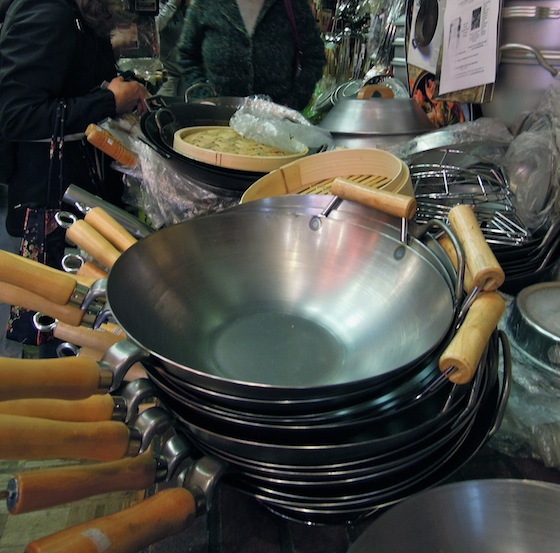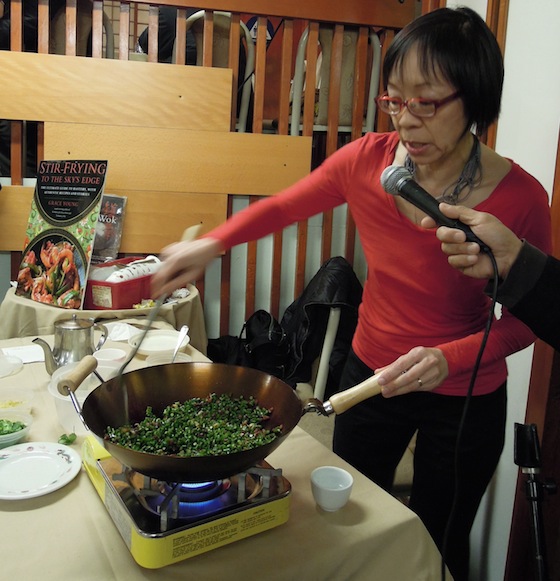
Young demonstrates how to judge when the preheated wok is hot enough (as soon as a drop of water evaporates on contact) then swirls in the oil and quickly adds her vegetables. One tip she imparts is to listen to your food cook, “That sizzle is the wok talking to you. If you don’t hear it, it’s not hot enough.” Her green beans turn out crunchy with a delicate, smoky wok flavor, which Young says sets it apart from stir-fries made in a skillet or non-stick cookware.
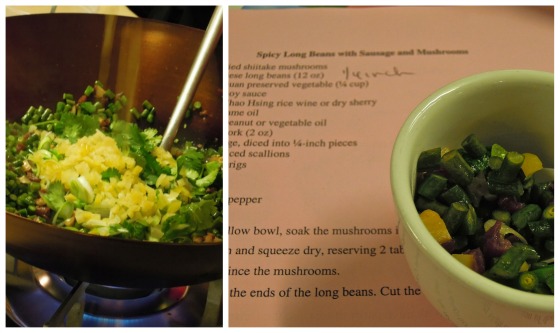
Meanwhile, upstairs, a Chinese calligrapher inks lucky characters on red paper, and the guests line up to fill their plates with lucky foods. Wilma Pang, one of the organizers of today’s event, under the auspices of A Better Chinatown Tomorrow, explains the symbolism of the foods arranged on the buffet table.
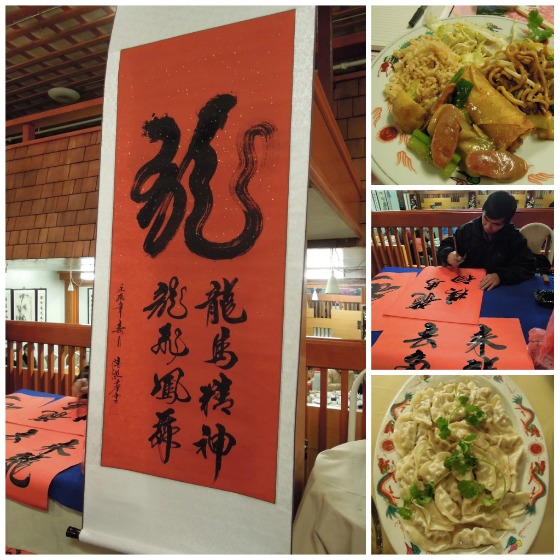
Many dishes are considered lucky because their Chinese names are homonyms for auspicious goals; others insure a good year because of their shapes or colors.
“The word for celery (choi) is a homonym for hard work,” Pang explains, and it portends the monetary result of all that effort. Green onions stand for intelligence; the turnip cake signifies that things will keep getting better. The apple means smooth sailing ahead and the tangerine is considered lucky because its orange color connects to gold. Its leaves represent growth and prosperity.
Although, many Chinese New Years foods vary by family and village, the one universal dish is crescent shaped dumplings. Traditionally, dumplings are made on New Years Eve by all the members of the family, working together. Their shape represents gold ingots and so symbolizes good fortune for the upcoming year. “The more you make, it’s like putting money in the bank,” says Pang. “And often, we hide a coin in one dumpling for a lucky diner to find.”
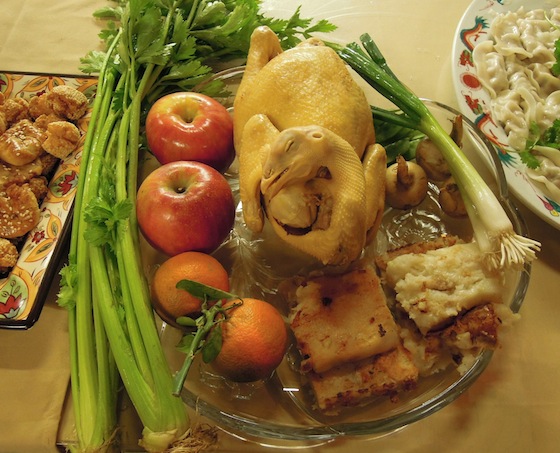
Pang points out the chicken with its head and feet still attached. “Very important to cook an entire chicken, for family togetherness.”

“See these cookies that open up with a smiling face, they represent happiness,” says Pang.
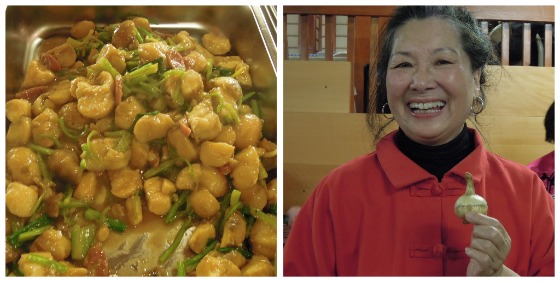
During the meal, there is one dish that has even the Chinese diners stumped. What are those roundish starchy vegetables? “Arrowroot,” Pang answers and holds up a fresh one, slyly smiling as she explains, “See this shape, with the little part that sticks out – that’s for having boy babies.”
After lunch, I have a chance to chat with Grace Young and ask her a few questions.
She grew up eating the traditional Cantonese foods her parents prepared. But at age 12, discovered Julia Child on TV and became fascinated with French cooking, and its entirely different culinary vocabulary. After apprenticing with French chef Josephine Araldo in San Francisco, Young moved to New York in 1979, and worked writing and testing recipes for General Foods. Then she ran the test kitchen at Time Life Books for 18 years, and produced more than 40 cookbooks that spanned the globe.
A chance comment from a cousin ignited the spark of Young’s passion to explore her own family’s culinary culture. Her cousin said, ”When it comes to Chinese cooking, I don’t even try because you can’t beat the Chinese take-out in San Francisco.” Young feared that if most second generation Chinese shared her cousin’s indifference towards learning to make the food of their ancestors, a wealth of authentic recipes and foodways might disappear.
For three years, she made numerous visits to San Francisco to learn her parents’ and family’s recipes. This led to her parents sharing stories about customs and traditions associated with the food, as well as tales from their lives in China that she had never heard before. Young’s first book, The Wisdom of the Chinese Kitchen, was published in 1999 and won the IACP Best International Cookbook. Young is proudest of this book because she feels it preserves traditional Chinese home cooking.
Is the dish you made today special for Chinese New Year's?
Not specifically, but it has mushrooms which grow quickly and so symbolize prosperity. I made this dish today because it’s one of my mother’s favorites. Now that she’s getting older and doesn’t cook, I’m so grateful I have recorded her recipes in my book. When I go back and reread them, it’s as if I can hear her still talking to me through the recipes. For all these years, she always made the New Year’s Eve meal and now in the last few years I am able, through my book, to make it for her. It’s ironic because I always thought that I was writing for the next generation. And in a million years I never dreamed I would give this back to my mother. When I make her a special New Year’s dish, like turnip cake, her face lights up, because food is memory.
Is there a certain dish you always have for New Year's eve dinner?
Fish is the standard dish at the end of the meal. The word for fish “yu” means wish and signifies abundance. It is essential to serve the complete fish, with the head and tail attached to ensure a good beginning and end to the year. Traditionally purchased live from a tank where one can pick out a strong swimmer, the poached fish with scallions and ginger is served as the last course of the New Year’s Eve feast, but not completely consumed. The leftovers are eaten the next day, so that its abundance will spill over into the New Year. Lobster, as the king of the ocean, represents the energy of the dragon. But any seafood is auspicious. Shrimp, whose name ha sounds like laughter, represents happiness; the shells of clams and scallops resemble old Chinese coins and therefore portend prosperity. Also, the clam shells open as you stir fry them, signifying a new beginning.
What's the difference between the Chinatowns in San Francisco and New York?
For me, San Francisco Chinatown has such sweet memories. My father was a liquor salesman and so the owners of every restaurant and shop knew him and gave us a special welcome. Plus, the produce in California is so much more abundant and pristine in quality, especially the Asian vegetables. I love the hustle bustle and energy of shopping on Stockton Street. When a grocer brings out a new box of baby bok choy or snow pea shoots and rips it open, all of a sudden everyone lunges towards it with frenzied excitement and all these hands try to grab the freshest greens.
As we finish our interview, I accompany Grace on a short walk to The Wok Shop, a bustling little warren, filled chock-a-block with woks, gadgets and cooking accessories, whose owner Tane Chan graciously provided the seasoned wok for today’s cooking demonstration.








